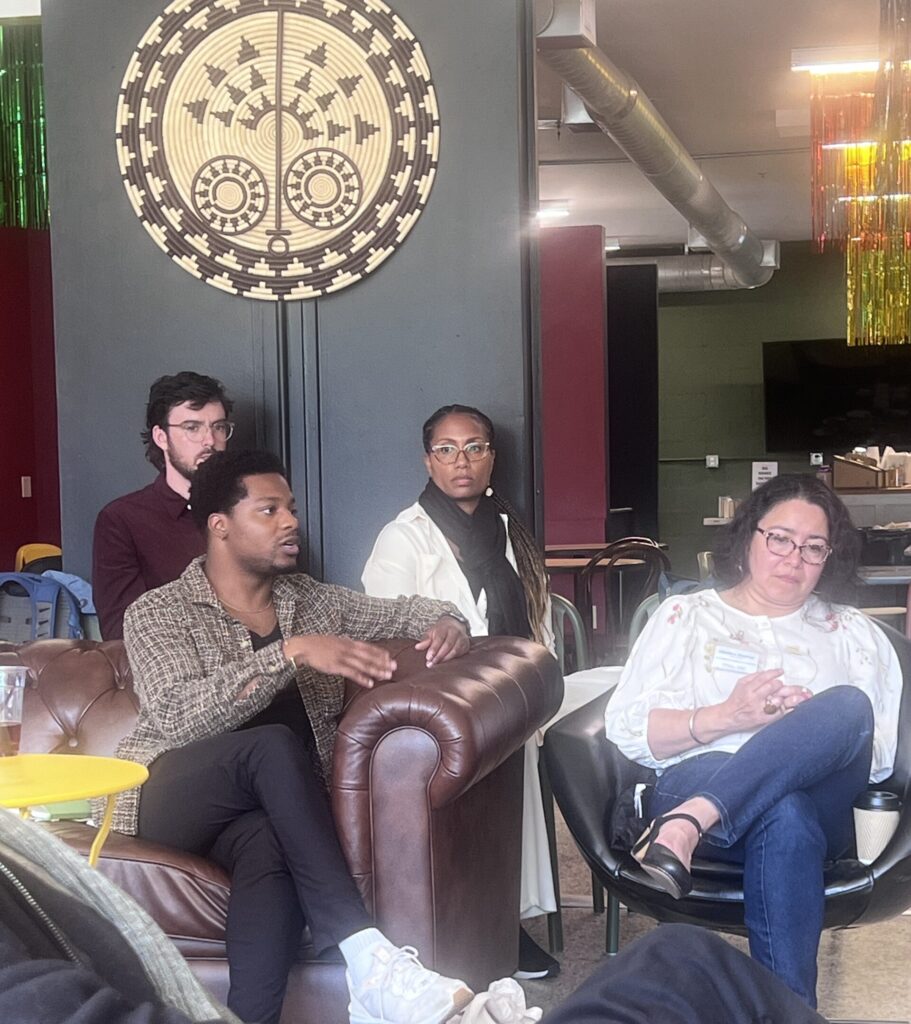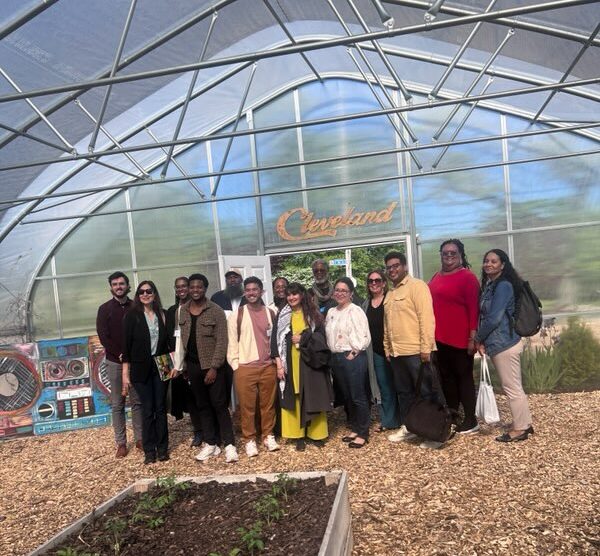BY Jarryd Bethea, PLACES Fellow and Senior Research Associate, Atlanta Wealth Building Initiative
The time I spent during our recent PLACES Fellowship site visit in Cleveland demanded that I abandon the assumptions I arrived with: It’s just another city in the Midwest.
Leaving those assumptions behind meant that I could become better acquainted with Cleveland, practice community with the residents who are fervently working to shape the city’s outcomes and open myself to the lessons ready to be taught.
I want to begin by acknowledging that the land we were in community with (which is now settled as Cleveland, Ohio) belongs to the Mississauga, Kaskaskia, and the Erie Native American people.
I have always regarded land acknowledgments as progressive, seemingly the first step of a reparative approach. Cynthia Connolly of the Lake Erie Native American Council provided a timely reminder that a land acknowledgment will never suffice in place of the full context and support of her people. The termination era from the 1950s-1960s is characterized as the period where the U.S. government acted to assimilate Native Americans into western society within the United States. The Bureau of Indian Affairs offered incentives such as jobs and economic security to those willing to relocate to urban cores.
Cleveland was among these originally designated cities.
Unfortunately, many of the promised benefits were not realized. Despite the broken trust and false offerings made to the Indigenous peoples, a resilient and interconnected community in Northeast Ohio began to thrive.
There are many stories and histories of shared relationships between Indigenous and Black communities of Ohio — one of which is St. John’s Episcopal Church.
This church held gatherings for Indigenous folks, providing a space for them to congregate and mobilize during the termination era. St. John’s is also known to have been one of the last stops on the Underground Railroad for enslaved Blacks seeking respite from the country’s injustices.
This grounds me in the reminder that Indigenous peoples and Black Americans in this country share an extensive number of experiences, including their mistreatment and displacement. This reminder is humbling — and humility remains a core tenet of learning.

PLACES Fellow Jarryd Bethea and other members of the 2024 PLACES Cohort gathered in Cleveland in May.
As a policy practitioner at the intersection of economic development and community advocacy, my work centers on wealth-building practices that emphasize the collective power of Black communities across the South.
Much of the disruption and displacement of Black communities in Atlanta — the primary geographic area for my work — is due in part to extraction and the desire to create something new. This is not dissimilar to the plight of America’s Indigenous communities, who have also borne the violence of erasure rooted in racism. I look to our Indigenous brothers and sisters for lessons in fighting to maintain our whole identities, stories, culture and communities against American settler colonialism.
Erasure as a tool of oppression is still settling with me as a foundational truth of white supremacy and I continue to sit with the ways it will manifest.
As the country’s policy landscape experiences a retrenchment — evidenced by the overturning of Roe v. Wade, the ruling on the Fearless Fund, and the passing of restrictive legislation whose impact and legacy of harm cannot be understated when discussing marginalized identities — it is increasingly important that we mobilize ourselves, tell our stories and embody the forms of joy we engage in. Cleveland is a city that has set an example for all three.
Let me share just a few of the folks we met in Cleveland and how they embody the above call to action:
The work of Jazmin Long and Tonae Bolton at Birthing Beautiful Communities is a lionhearted act of care that embraces mothers from expectancy to well after the baby has arrived. Born out of the need for better maternal care for Black mothers, they have scaled their organization to actively support between 250 and 300 clients.
Pairing their practice with research and advocacy, the organization is striving to make a difference in Ohio’s healthcare system. While the work may be difficult, Jazmin still made time to center joy during an impromptu karaoke session with our PLACES cohort.
We met with the Partnership for Equitable and Resilient Communities (PERC), a collaborative of funders, city officials, and community organizers working to advance equitable development in Cleveland, utilizing public and private dollars in service of Black, Latino/a/x, and Indigenous communities. It was inspiring to see a group so cohesive and supportive of one another — offering the reminder that developing deep relationships rooted in care is a prerequisite for impactful work.
And finally, Rid-All Green Partnership. Located in a part of Cleveland known as the Forbidden Triangle, this community space was a longtime site of illegal dumping, disinvestment and neglect. It has now been transformed into a 15-acre urban farm that encompasses a community kitchen and offers environmental programs while tackling food insecurity. The radical repurposing of this space has yielded a valuable and joy-filled asset to the community.

The PLACES Fellows visited the Rid-All Green Partnership, which turned an empty and forgotten piece of land in Cleveland’s Kinsman Neighborhood into an urban farm.
My PLACES site visit shared many similarities with my current work supporting local policy. Most of all, there was an emphasis on the need for Black and Indigenous residents to access self-determination and decide for themselves how they would like to see their communities change.
Admittedly, Cleveland is changing in a very different way than Atlanta, as it is considered a city in decline. Once home to almost one million residents, it now has a population of only 360,000.
However, Kaela Geschke with Trust for Public Land believes that Cleveland may become a climate refugee city in the future due to rising global temperatures and the city’s idyllic positioning near fresh water and mild temperatures. This migration and its impact on the city’s economic development remains to be seen.
My time in Cleveland was replete with witnessing acts of service that left me with the desire to learn more and do more. For now, I believe it remains essential that we underscore self-determination in community outcomes to debase erasure as a tool of racism.
About the Author
 Jarryd Bethea is a member of TFN’s 2024 Fellowship Cohort and a senior research associate at the Atlanta Wealth Building Initiative.
Jarryd Bethea is a member of TFN’s 2024 Fellowship Cohort and a senior research associate at the Atlanta Wealth Building Initiative.
Featured image: The 2024 PLACES Fellows gathered in Cleveland for the third site visit of their fellowship year.
